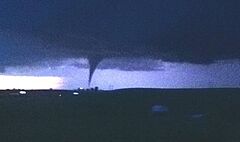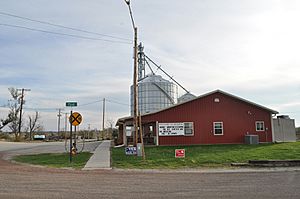Reading, Kansas facts for kids
Quick facts for kids
Reading, Kansas
|
|
|---|---|
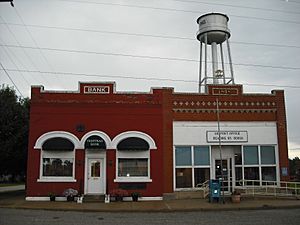
Downtown Reading (2009) (prior to tornado)
|
|
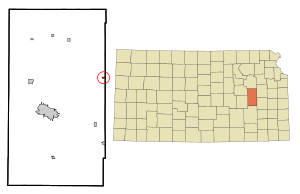
Location within Lyon County and Kansas
|
|
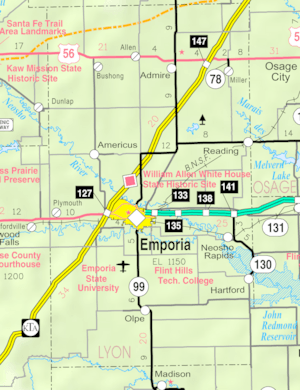
|
|
| Country | United States |
| State | Kansas |
| County | Lyon |
| Founded | 1870 |
| Platted | 1870 |
| Incorporated | 1890 |
| Named for | Reading, Pennsylvania |
| Government | |
| • Type | Mayor–Council |
| Area | |
| • Total | 0.21 sq mi (0.55 km2) |
| • Land | 0.21 sq mi (0.55 km2) |
| • Water | 0.00 sq mi (0.00 km2) |
| Elevation | 1,093 ft (333 m) |
| Population
(2020)
|
|
| • Total | 181 |
| • Density | 862/sq mi (329/km2) |
| Time zone | UTC-6 (CST) |
| • Summer (DST) | UTC-5 (CDT) |
| ZIP code |
66868
|
| Area code | 620 |
| FIPS code | 20-58600 |
| GNIS ID | 2396331 |
Reading is a small city in Lyon County, Kansas, United States. In 2020, about 181 people lived there. It's a quiet place with a rich history.
Contents
History of Reading, Kansas
For thousands of years, the land that is now Kansas was home to Native American tribes. In 1803, the United States bought most of modern Kansas as part of the Louisiana Purchase. This was a huge land deal with France.
Kansas Becomes a State
Later, in 1854, the U.S. Congress created the Kansas Territory. Kansas officially became the 34th state in 1861. This was an important step in the state's development.
How Reading Was Founded
In 1863, a railway company called the Atchison, Topeka and Santa Fe Railway was given a lot of land in Kansas. This was on the condition that they would build a railroad line across the state. Construction started in 1868.
By 1870, the first Santa Fe train reached a town called Emporia, which was close to where Reading is now. People working for the railroad decided to create a new town. They named it Reading after Reading, Pennsylvania, where the land owners were from. The town was officially laid out, or platted, in 1870.
Early Days of Reading
The first post office in Reading opened in August 1870. The town grew, and in September 1890, Reading officially became an incorporated city. This means it became a legal town with its own local government.
The 2011 Tornado in Reading
On May 21, 2011, a powerful tornado struck Reading. It was an EF3 tornado, which means it had very strong winds. The tornado was about three blocks wide and traveled for four miles.
The storm caused a lot of damage. It destroyed or badly damaged over half of the homes and businesses in the city. The post office and fire station were also hit hard. Sadly, one person died, and two others were hurt. The damage cost more than $2.2 million.
Reading Rebuilds
After the tornado, the community worked hard to rebuild. With help from the Federal Emergency Management Agency (FEMA), most of the town was rebuilt within a year. By 2023, Reading had largely recovered from the disaster.
Geography and Climate
Reading is located at the eastern edge of Lyon County. It's about 15 miles northeast of Emporia and 14 miles southwest of Osage City. You can find it along Highway 170.
Land Area
The city covers a total area of about 0.20 square miles (0.55 square kilometers). All of this area is land, with no large bodies of water.
Reading's Climate
Reading has a climate known as a humid subtropical climate. This means it has hot and humid summers. The winters are generally mild to cool.
Population and People
| Historical population | |||
|---|---|---|---|
| Census | Pop. | %± | |
| 1880 | 120 | — | |
| 1900 | 304 | — | |
| 1910 | 289 | −4.9% | |
| 1920 | 358 | 23.9% | |
| 1930 | 341 | −4.7% | |
| 1940 | 302 | −11.4% | |
| 1950 | 289 | −4.3% | |
| 1960 | 249 | −13.8% | |
| 1970 | 247 | −0.8% | |
| 1980 | 244 | −1.2% | |
| 1990 | 264 | 8.2% | |
| 2000 | 247 | −6.4% | |
| 2010 | 231 | −6.5% | |
| 2020 | 181 | −21.6% | |
| U.S. Decennial Census | |||
Reading is part of the larger Emporia area, which is a small metropolitan area.
Who Lives in Reading?
According to the 2020 United States census, 181 people lived in Reading. Most residents were White or European American. A small number of people were from other racial backgrounds or identified as having two or more races. About 1.1% of the population was Hispanic or Latino.
There were 80 households in the city. About 36% of these households had children under 18 living with them. The average household had 2.4 people. The median age of residents was 42.3 years old. This means half the people were younger than 42.3, and half were older.
Education in Reading
The public schools in Reading are part of the North Lyon County USD 251 school district. The main office for the district is in Americus.
Local Schools
Students in the area attend Northern Heights High School, which is located east of Allen. Their school mascot is the Wildcats. Younger students go to the NLC Elementary School and the NLC Early Learning Center (preschool) in Americus.
Past Schools in Reading
Reading used to have its own high school, called Reading High School. Its mascot was "The Reading Lions." This high school closed in 1980. The Reading Elementary School also closed at the end of the 2017-2018 school year.
Notable People from Reading
- Jim Barnett grew up on a farm near Reading. He later became a politician and ran for governor of Kansas in 2006.
- Robert D. "Bob" Price (1927–2004) was born in Reading. He later served as a U.S. Representative for Texas from 1967 to 1975.
See also
 In Spanish: Reading (Kansas) para niños
In Spanish: Reading (Kansas) para niños


